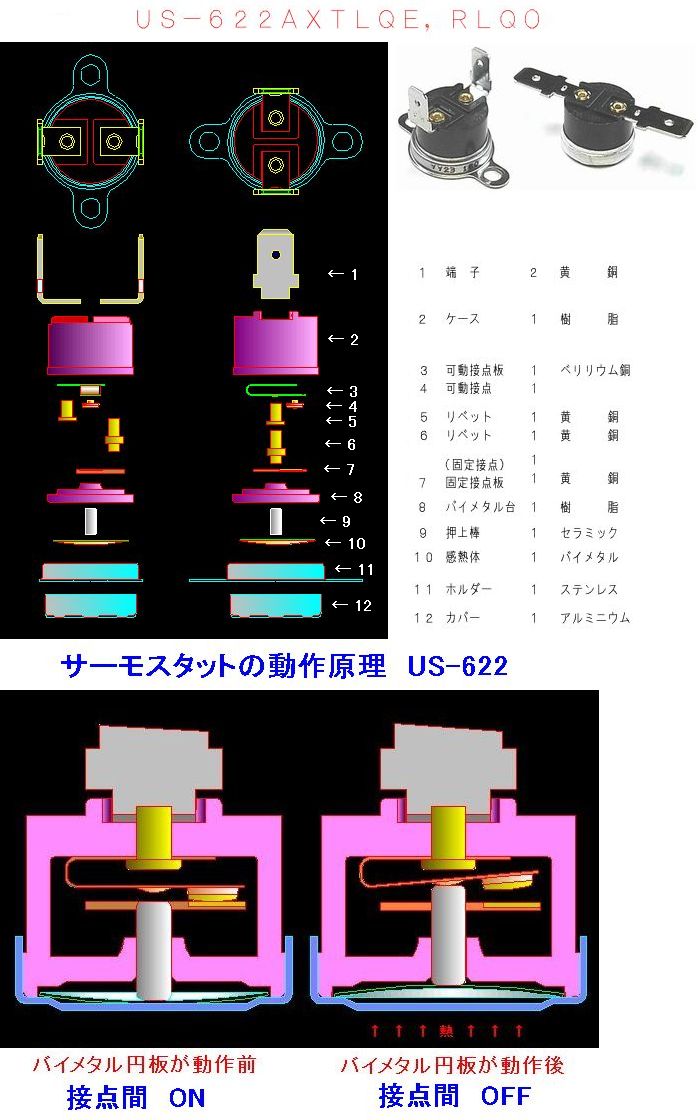What is a thermostat?
| ● • Themostat | |
| A device that stabilizes heat and temperature The etymology for thermostat is a compound word combining “thermo” which means temperature or heat, and “stat” which means a stationary state. “Thermo” is how the word is pronounced in English, but in German it is pronounced “terumo” or “tamu”. |
|
| ● • Purpose | |
| (1) Temperature regulator (controller): Maintains a certain degree of temperature.
(2) Excess temperature rise protector (limiter/protector): Turns off the heat source when the temperature rises above a particular level. (3) Temperature detector: Signals when the set temperature has been reached and causes another operation to occur. |
|
| ● • Asahi’s Thermostat is a bimetal thermostat. | |
| The temperature switch senses the temperature through the bimetal and controls the electricity contacts (turning them on or off). There are various kinds of devices for temperature control and measurement. |
|
What are the principles of bimetal?
| ● • Bimetal | Two metals (a low expansion metal and a high expansion metal) are milled into a single sheet using a roller → Bimetal |
| ● • Bimetal is a compound word | combining “bi” (a prefix meaning “two”) and “metal.” |
| ● • Pressurized bonding | Bonding by cool or hot rolling (molecular bonding). No adhesive is used. |
| ● • Materials | High expansion metal contains an iron alloy (Fe) and nickel (Ni) with added substances Cr, Mn, and Mg; low expansion metal contains iron (Fe) and nickel (Ni) as the main materials for Invar (Ni35-Fe) |
| ● • Bimetal bends in one direction as the temperature rises and in the other direction as it falls. | |
| ● • Force arises where the movement is controlled, and in the thermostat the set point pressure exerts a repelling force. | |
Structure and mechanism of the thermostat US-622 ON・OFF

Types, structures and purposes of bimetal thermostats
● • Types and structures
| PLaminated type | In this type, parts have been laminated together and fastened with a rivet, facilitating temperature variations in small increments. |
| Snap disc type | In this type, parts are contained in a covered case. It has a relatively large differential, and uses a low cost snap disc to prevent excessive temperature rises. |
| Protector type | This type is contained in a covered case, with, a snap disc integrated into the electric circuit for the detection and prevention of temperature rises or overcurrent situations. |
● • Applications
| Home electric appliances | Home electric appliances: Kitchen goods (Computerized hot water kettles, coffee makers, ovens, hot plates, rice-cake makers, etc.) Heating devices: Electric space heaters, electric heating pads, electric kotatsu (coffee-table type heaters with coverlets), panel heaters, electric mats, etc.) Others: Ironing presses, hair dryers, vacuum cleaners, futon dryers, etc.) |
| Household goods | Lavatory seats, washlets (a seat-type of bidet incorporating seat warming and warm water irrigator), battery chargers, etc.) |
| Gas and oil | Bathtub boilers, water heaters, floor warmers, fan heaters, space heaters, etc.) |
| Others | Copy machines, automatic vending machines, automobiles, motorboats, marine jets, etc. |
| Industrial equipment | Construction tools, road signs, welding machines, etc. |
![]()










